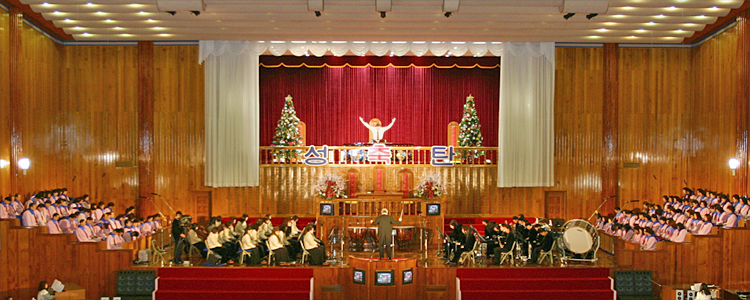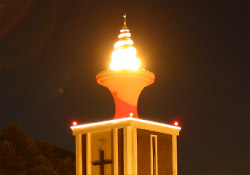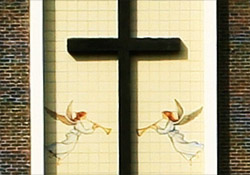Algok-seongjeon (Temple of Grain)
Algok-seongjeon is the fourth church God commanded to be build and is prophesied in the Bible. (Revelation 14:15) In the Book of Revelation, an angel appears from within a temple to call upon a man holding a sharp sickle, the Second Olive Tree-he who must harvest the fruitful grains. That temple is Algok-seongjeon, the Temple of Grain.
The Exterior of the Church

God first showed Moses the Holy City in Heaven and commanded him to build a Tabernacle. (Exodus 26:30) The Lord showed David the second temple and had Solomon build Solomon’s Temple. (1Chronicle 28:19) God commanded Zerubbabel to build Zerubbabel’s Temple to replace the fallen Solomon’s Temple. (Haggai 1:8) Lastly, God commanded the Overcomer to build Algok-seongjeon by showing him how it should look. Lee Young-soo, the Overcomer dropped out of middle school and never learned architecture. He relies solely on his visions to build Algok-seongjeon and its annexes.
In 1980, the Lord gave command to Lee Young-soo, the Overcomer, “Build my temple in quiet place about an hour away from Seoul and bring glory to me,” and showed him the temple’s design and its surrounding areas in his vision over the course of years. Following his command to build a temple, Lee Young-soo, the Overcomer bought a mountain in Gapyung in 1985, started building on January 9th, 1987 just as he saw in his visions from God, and dedicated the Church on November 6th, 1987. After the church was completed, the Lord said, “You went through hardship and trouble to build my temple,” and promised, “I will make you noble from now on.” In 1990, God said to Lee Young-soo, the Overcomer, in his vision, “Your followers will come into my world through this temple.”
The Interior of the Church

Algok-seongjeon’s width and height match those of Noah’s Ark, and its length by half. Jesus said the final days are like Noah’s times. He was implying catastrophes in the midst of people’s ignorance, but according to God’s command to build the temple, it can be known that it was built to link to Noah’s Ark.
Incense

The spiraling form on top of Algok-seongjeon symbolizes the smoke from an altar’s incense burner. The smoke represents worship to God, and it signifies woship from Algok-seongjeon being delivered to God. (Revelation 8:4)
Seven Angels

The seven angels on the front of Algok-seongjeon represent the seven angels conducting God’s catastrophes. (Revelation 8:6) Each one of them holds a trumpet. This represents God putting the world and the Devil on trial through the seven angels, once his Providence is completed through Algok-seongjeon.
Dove and the Olive Tree

There are two flying doves carrying the branches of an Olive Tree. This represents the Holy Spirit. It symbolizes that the work of the Olive Tree is with the Holy Spirit. (Zechariah 4:10)



